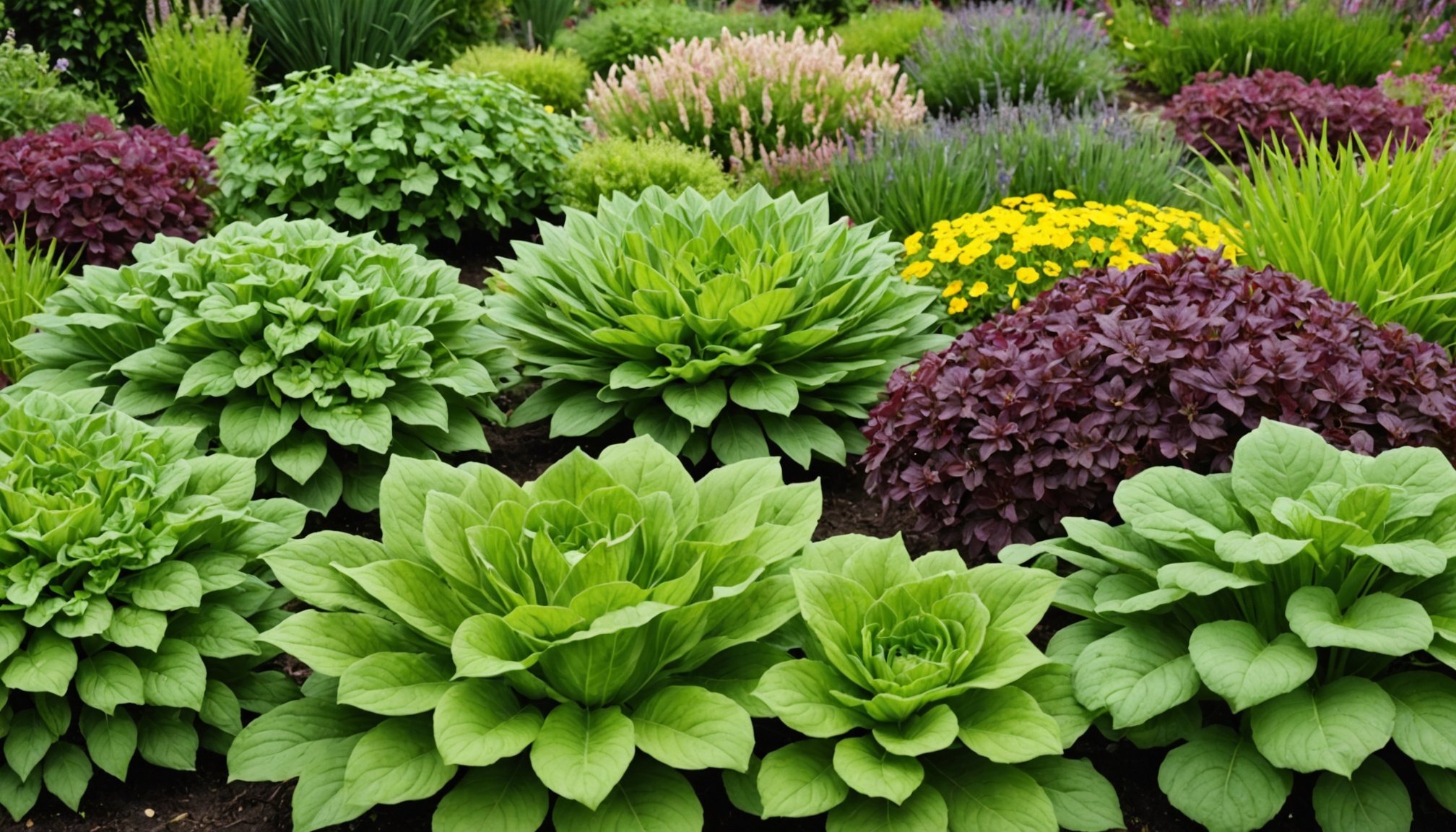Overview of Perennial Vegetables
Perennial vegetables are a delightful addition to any garden, particularly for those enthusiasts keen on achieving long-term, sustainable produce. Unlike annual vegetables which need replanting each year, perennial vegetables return season after season, reducing toil and enhancing resilience in your gardening space. They have unique characteristics, including hardy growth habits and adaptability to various conditions, making them particularly beneficial.
Incorporating perennial vegetables into your gardening practice offers numerous benefits. These plants often require less intensive soil preparation and management once they are established. Over time, they establish deeper root systems which improve soil structure and inhibit erosion, thereby enriching the ecosystem of your garden. Additionally, they contribute to biodiversity, creating a balanced, thriving environment.
In parallel : Ultimate guide to thriving uk orchids: key strategies for cultivating a vibrant collection
The UK’s climate poses specific challenges and opportunities for perennial vegetables. Some species have adapted exceptionally well to the varied climate and soil conditions found in the UK, demonstrating impressive frost tolerance and temperature endurance. From skirret to perennial kale, these vegetables can thrive with proper care. Such adaptability ensures a rewarding harvest and complements the unique gardening conditions across different regions.
Soil Preparation for Perennial Vegetables
The importance of soil preparation cannot be overstated, especially when aiming for successful perennial vegetable cultivation. Perennial vegetables thrive best in rich, fertile soil that promotes robust growth. To achieve this, fertilization plays a key role. Incorporating compost and well-rotted manure are excellent ways to enrich soil with essential nutrients, fulfilling the fertilization requirement.
Also to read : Mastering blueberry growth: key strategies for thriving in acidic uk soil
Good soil preparation also involves ensuring adequate drainage, as overly saturated soil can harm plant roots. Amending the soil with organic matter such as compost or sand can improve soil structure, enhancing drainage and aeration. Sandy loam soils often provide an ideal condition due to their excellent drainage capabilities, crucial for perennial vegetables.
It is essential to periodically test the soil to determine pH levels and nutrient content, allowing for appropriate adjustments. Balancing the soil’s acidity or alkalinity with lime or sulfur as needed will foster optimal conditions. Furthermore, using raised beds can also aid drainage and soil structure, especially in areas prone to heavy rainfall. These practices ensure that perennial vegetables receive the best possible start, leading to a thriving and bountiful garden over time.
Climate Considerations in the UK
Understanding climate factors is crucial for successful gardening, especially with perennial vegetables. The UK’s diverse climate zones significantly impact growth. Areas in the south tend to experience milder winters, allowing for more temperature-tolerant crops. Meanwhile, areas in the north may encounter harsher conditions, affecting plant selection.
Frost tolerance is an essential consideration. Many perennial vegetables are naturally frost-hardy. For example, perennial kale and leeks flourish even in frosty conditions. To bolster plant resilience, it’s advisable to select species suited to the local climate. Wade through catalogues of hardy options to enhance your garden’s success rate under varying climate factors.
When faced with extreme weather, implement strategies to protect your plants. Consider using cloches or fleece during unexpected frost or harsh weather conditions to shield your crops. Creating wind breaks with hedges can also prove effective, mitigating damage from strong winds.
These strategies ensure perennial vegetables thrive amidst the UK’s unique climate challenges. You will foster a flourishing garden environment capable of yielding abundant produce year-round.
Selecting Suitable Perennial Vegetables
Perennial vegetables offer remarkable opportunities for UK gardeners, especially when selecting suitable species that thrive locally. Understanding different varieties can significantly boost your gardening success.
List of Recommended Perennial Vegetables
- Rhubarb: Adapts well to the UK climate, often found in both allotments and gardens.
- Asparagus: A favourite for its rich taste, performs best in well-drained, sandy soil.
- Perennial Kale: Exceptionally hardy, enduring harsh winters and continuing to produce over many harvests.
Characteristics of Each Variety
Each perennial vegetable boasts unique traits suited for specific conditions. Rhubarb, for instance, enjoys moist, fertile soil. Asparagus requires full sun and benefits from regular weed removal. Meanwhile, perennial kale accommodates various soil types, making it a resilient choice.
Considerations for Planting
When planting these versatile vegetables, consider spacing to allow ample growth. Rhubarb and asparagus need ample room, while perennial kale is more forgiving. Evaluate sun exposure, ensuring adequate light for asparagus, which influences yield and flavour. By understanding each vegetable’s preferences, you can tailor your garden to meet their needs, ensuring a thriving, productive garden space in the UK climate.
Maintenance Tips for Thriving Perennial Vegetables
Maintaining perennial vegetables requires consistent and thoughtful care to ensure robust growth and productivity. Effective watering practices are crucial; these plants generally prefer well-drained soil and regular, but not excessive, watering. Ensuring even moisture distribution around the root zone promotes healthy growth and helps prevent disease.
An often overlooked practice, mulching plays a vital role in soil moisture retention and weed control. By applying organic mulch, such as straw or wood chips, around the base of Perennial Vegetables, you can conserve water, maintain soil temperature, and suppress unwanted weeds. This practice not only aids in reducing evaporation but also helps improve soil structure over time.
Seasonal maintenance tasks are essential to encourage healthy growth in Perennial Vegetables. In early spring, ensure beds are cleared of debris to prevent over-wintered pests and diseases. Regular monitoring and removal of dead foliage and spent flowers help direct energy into new growth. Additionally, applying a balanced all-purpose fertiliser at the beginning of the growing season can support vigorous development.
By following these maintenance practices, you not only enhance the resilience of your Perennial Vegetables but also boost their yield and flavour, making your gardening efforts more rewarding.
Sustainability Practices in Perennial Vegetable Gardening
Incorporating sustainability into your perennial vegetable gardening not only benefits your garden but also enhances the surrounding ecosystem. Sustaining an environment where biodiversity thrives ensures that your garden remains healthy and productive. Encouraging diverse plant species attracts beneficial insects and wildlife, creating natural pest control and minimizing the need for chemical interventions.
Organic gardening practices are central to sustainability, reducing reliance on synthetic fertilizers and pesticides. Using organic waste like vegetable peels and garden trimmings to create compost enriches the soil and promotes plant health. Integrating green manure crops can fix nitrogen in the soil and suppress weeds, offering cost-effective alternatives to traditional methods.
To further support biodiversity, implement companion planting by pairing perennial vegetables with herbs and flowers. This practice deters pests and enhances pollination, emphasizing nature’s role in sustainable gardening. Select native species that have adapted to local conditions, ensuring resilience and reducing water usage.
By practicing sustainability, gardeners contribute positively to the environment. This leads to a harmonious balance where biodiversity flourishes, soil is nourished organically, and perennial vegetables provide rewarding yields. The approach cultivates a sustainable cycle benefiting both the gardener and the overall ecosystem.
Pest Management Strategies
Gardening, particularly with perennial vegetables, calls for vigilant pest control to protect your crops. Various pests such as slugs, snails, and aphids commonly target these plants in the UK. Identifying these pests promptly is crucial for effective management and ensuring healthy growth.
Favouring organic methods in pest management not only safeguards your vegetables but also preserves the environment. Techniques like companion planting can deter pests naturally. For instance, planting marigolds can ward off nematodes, while mint and garlic repel aphids. Moreover, introducing predatory insects like ladybirds can help reduce aphid populations without chemicals.
Prevention stands at the forefront of successful pest management. Regularly inspecting your plants can prevent infestations from taking hold. Employing barriers like copper tape around garden beds deters slugs and snails, offering protection. Additionally, maintaining clean garden conditions by promptly removing debris and fallen leaves can limit habitats for pests.
By integrating these strategies, you can maintain healthier crops and contribute to a balanced ecosystem. Emphasizing organic and preventative approaches not only cultivates robust perennial vegetables but also supports an enduring, sustainable gardening environment.
Harvesting Techniques and Timing
Mastering harvesting techniques is crucial to ensure the best yield and flavour from perennial vegetables. Recognising the readiness of each type is essential. For example, rhubarb stalks should be harvested when they’re firm and vibrant, yet before they become overly fibrous. The art lies in determining when the vegetable is at its peak, capturing the perfect balance of texture and taste.
Timing significantly influences the yield. Many perennial vegetables develop more robust flavours when harvested at the right moment. For instance, asparagus should be collected when the spears are about 15-20 cm tall, capturing peak tenderness and flavour. Optimal timing not only enhances your culinary experience but also encourages future growth and higher yields.
To harvest without damaging the plant, employ the right techniques. Gentle twisting of rhubarb stalks, rather than cutting, encourages new growth. Precision tools like sharp knives or shears are advisable for delicate plants, reducing stress on the plant. These methods ensure the perennial vegetables continue to thrive and produce year after year, embodying a sustainable approach to home gardening that maximizes your garden’s productivity.



